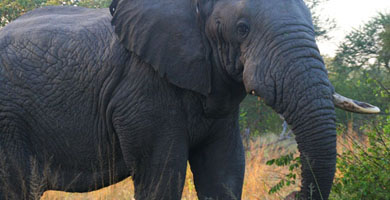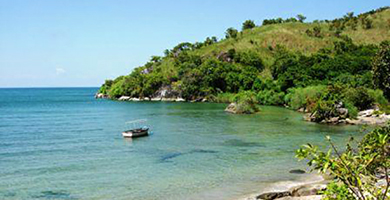Off-Season Adventures in the MASAI MARA
Suzan Crane explores one of Africa’s iconic destinations when game is plenty and visitors are scarce.
The small plane hovers low over the sprawling scrub-pocked grassland’s of Kenya’s famed Masai Mara, a tapestry of grazing wildlife looming ever larger as we approach the muddy airstrip. Flat-topped acacia trees dance under a metallic sky that threatens rain, majestic elephants and towering giraffes shadowed in an endless wave of distant horizons. The few passengers onboard scatter to a few remaining open camps, the world’s “Seventh New Natural Wonder” all but deserted in low season. I’m quite happy, though, to be a Lone Ranger in God’s Wild Kingdom, dodging the crowds that flood the Mara each July to October during the Great Migration of wildebeest, zebras and other plains game to and from Tanzania’s Serengeti National Park.
I’m greeted by Teketi “Stephen” Nabaala, my shuka-clad Masai guide, who deftly pilots a sturdy jeep through gluey muck and rocky ravines to deposit me at the exclusive Ngerende Island Lodge. One of the region’s newer upscale properties, the elegant wood and canvas lodge is set on an oxbow and almost completely encircled by the Mara River (hence “Island Lodge”). Exuding a quiet luxury in sync with its natural surroundings, Ngerende features seven chic riverfront suites, a spa, infinity swimming pool and ambient restaurant where sumptuous daily feasts– highlighted by organic produce grown onsite — are served to those not opting for private dining. The lodge also maintains its own airstrip and operates Ngerende In The Wild, a “designer” bush camp, that was unfortunately being refurbished during my visit.
With solicitous personal service Ngerende’s hallmark, I spend three days lavishing in hospitality normally reserved for royalty. Any undeserving thoughts quickly dissolve as I melt into an open-air bubble bath prepared by my butler each evening, serenaded by the resonant bellows of hippos and crackling in-room fire. Responsible tourism, sustainability, and community support are embraced by most Mara camps and lodges, a commitment Ngerende also honors. In addition to inviting each departing guest to plant a tree, the lodge is currently constructing a local primary school and providing training workshops and equipment for local Masai women. Visiting the Mara during rainy season requires some stamina, but the challenges don’t diminish the rewards. While a few rutted dirt roads vein the vast savannah, we’re mostly forging our own paths over muddy flatlands and newly formed rivers. Occasionally we get stuck. But with such copious wildlife blanketing the 1500 kilometers of National Reserve and adjoining Conservancy land — who cares? It’s all part of the adventure.
Just moments into our first game drive we encounter a pride of lions feasting on zebra remains, scavenging hyenas waiting in the wings. More lions loll under a tree in the Park the next day, completely unfazed by our presence. Observing from only eight feet away, we remain transfixed until a cheetah and her two cubs divert our attention. Skulls and bones litter the landscape, evidence of recent predatory activity. Hordes of elephants lumber across the plains as omnipresent zebra and giraffes converge in protective groups. A buoyant Thomson’s gazelle inexplicably chases a rare Denham’s Bustard not far from where a gaggle of buffalo wallow in sludge. Impala, topi, leopards, baboons, warthogs… the entire spectrum of the Mara’s 95 mammal, reptile, amphibian (and 470 bird) species are present and accounted for.
Taking a safari hiatus one day, Stephen and I embark on a 30-kilometer two-hour journey to his ancestral family home. Upon our surprise arrival, news that a mzungu (white person) is onsite shoots through the simple communal compound like current through a power cable. Adults swathed in beaded jewelry, their ears stretched as is custom here, emerge from mud huts where there is surge of excitement but no electricity. Curious children bow their heads in respectful greeting, most never before having met a foreigner. I honor them with my visit, I’m told by Daniel, an Ngerende naturalist and one of Stephen’s many brothers. But as the first outsider to be invited here, the real honor is mine.
Stephen’s father approaches with a purposeful dignity that befits his status. With ten wives, 58 children, innumerable grandchildren and scores of cattle, the patriarch of this giant clan is a very wealthy man by Masai standards.
In Stephen’s humble adobe home, I share “white tea” — a Masai favorite — and translate conversations with several family members who embrace time-honored indigenous traditions in a world far removed from tourism. Outside, a group of women and children erupt into joyous song and dance. My awkward attempt at participation triggers great fits of laughter so I break in to a few of my own moves, prompting yet more smiles and giggles. As a parting gift, Daniel’s wife Senkei presents me with a customary beaded necklace. I’m deeply touched by the gesture. But truth is, my indelible experiences in the Mara would have been gift enough.
Ngerende Island Lodge is located on the Olchorro-Oirogua Conservation Ranch bordering Masai Mara Game Reserve in Naruk County, Kenya. It is a four hour drive or 30 minute flight from Nairobi.
Email: info@ngerende.com
Phone: +254 (20) 2103244
+254 (20) 2110609
ENTRANCE FEES:
Masai Mara Reserve: $80.00 (for non East-African residents)
Private Conservancies (if staying outside park): $70.00-$100.00 daily
Latest posts by Suzan Crane
- Tracking Tigers in NEPAL'S Royal Bardia National Park - June 4, 2014
- BALI by the Book: 10th Annual Ubud Writer's Festival - April 4, 2014
- Finding Serenity On The Shores Of LAKE MALAWI, Africa - February 7, 2014







